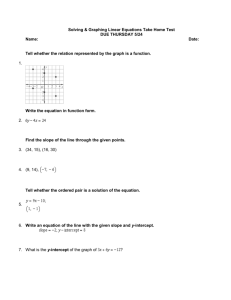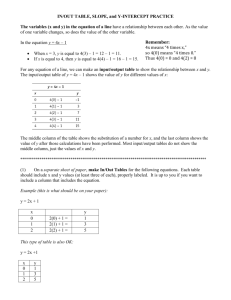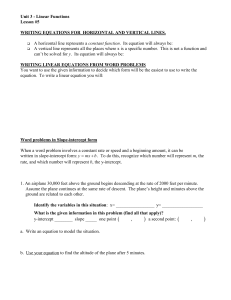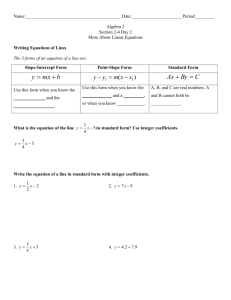Linear Relationships & Models Worksheet
advertisement
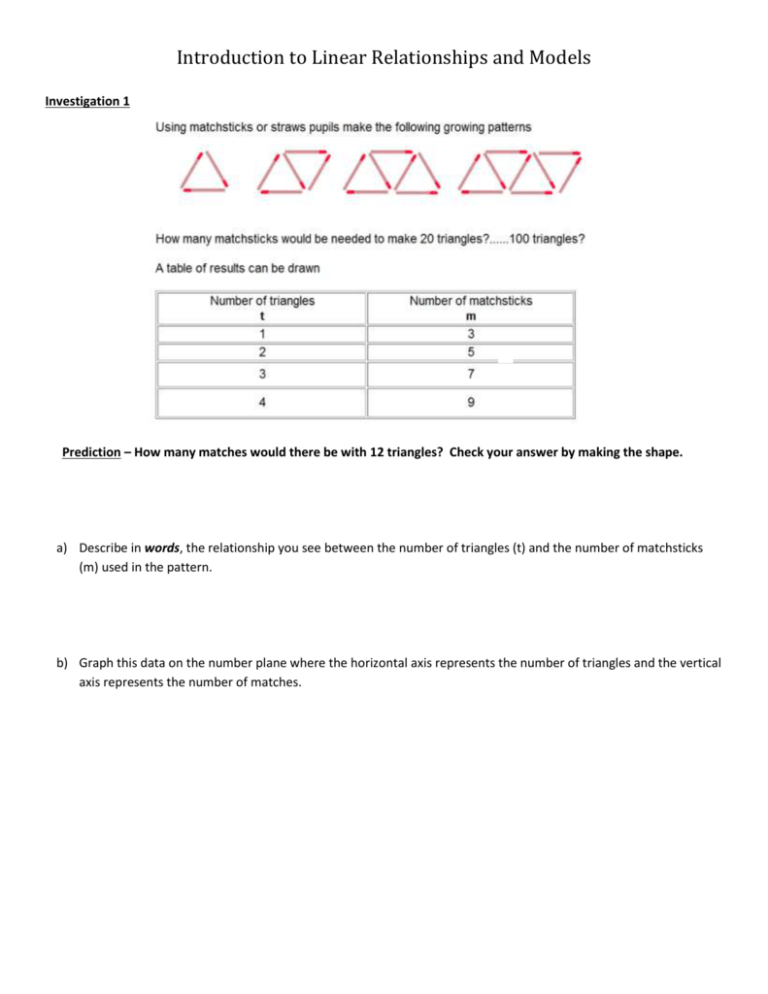
Introduction to Linear Relationships and Models Investigation 1 Prediction – How many matches would there be with 12 triangles? Check your answer by making the shape. a) Describe in words, the relationship you see between the number of triangles (t) and the number of matchsticks (m) used in the pattern. b) Graph this data on the number plane where the horizontal axis represents the number of triangles and the vertical axis represents the number of matches. Introduction to Linear Relationships and Models c) What do you notice about the shape of the graph? Explain WHY it may take this shape in context of your pattern. d) Calculate the SLOPE of your graph. What does the slope represent in context of this pattern? e) What is the y-intercept of the graph? What does the y-intercept represent in context of this pattern? f) Can you use the linear model: y = mx + b to represent your data? g) Using your graph, or otherwise, determine how many matchsticks would be used if there were 90 triangles? Show or explain how you determined your answer. c) Using your graph, or otherwise, determine how many triangles would there be if 401 matchsticks were used? Show or explain how you determined your answer. Introduction to Linear Relationships and Models Investigation 2 Let’s explore the relationship between the diagram number, and the total number of squares in each diagram. Complete a table of values with the data Diagram number (d) Number of squares (s) 1 2 3 4 a) Describe in words, the relationship you see between the diagram number (d) and the number of squares (s) in the pattern. b) Graph this data on the number plane where the horizontal axis represents the diagram number (d) and the vertical axis represents the number of squares (s). Introduction to Linear Relationships and Models c) What do you notice about the shape of the graph? Explain WHY it may take this shape in context of your pattern. d) Calculate the SLOPE of your graph. What does the slope represent in context of this pattern? e) What is the y-intercept of the graph? What does the y-intercept represent in context of this pattern? f) Can you use the linear model: y = mx + b to represent your data? g) Using your graph, or otherwise, determine many squares would be used in the 84th diagram? Show or explain how you determined your answer. h) Using your graph, or otherwise, determine which diagram would have 101 squares in it? Show or explain how you determined your answer. i) Can you draw a diagram with exactly 154 quares in it? Why or whynot? Introduction to Linear Relationships and Models Investigation 3 Ms. Makunja has trapezoidal tables in her room that fit 5 people comfortably around. But when she joins the tables together one of the students has to move to allow the tables to join together. Draw what it would look like to have 3 tables together. Complete a table of values with the data Number of tables (t) 1 Number of people (p) 5 2 3 a) Describe in words, the relationship you see between your variables. b) Graph this data on the number plane where the horizontal axis represents the number of tables (t) and the vertical axis represents the number of people (p). Introduction to Linear Relationships and Models c) What do you notice about the shape of the graph? Explain WHY it may take this shape in context of your pattern. d) Calculate the SLOPE of your graph. What does the slope represent in context of this pattern? e) What is the y-intercept of the graph? What does the y-intercept represent in context of this pattern? f) Can you use the linear model: y = mx + b to represent your data? g) Using your graph, or otherwise, determine how many people could be seated at 12 tables? Show or explain how you determined your answer. h) Using your graph, or otherwise, determine how many tables would be needed to seat 93 people? Show or explain how you determined your answer. i) Could we fit exactly 40 people around a seating arrangement like this? Why or why not? Introduction to Linear Relationships and Models Investigation 4 Write all the different variables that you see in this pattern_______________________________________________ Complete a table of values with the data Diagram number (d) 1 Number of squares (s) 4 2 3 a) Describe in words, the relationship you see between your variables. b) Graph this data on the number plane where the horizontal axis represents the diagram number (d) and the vertical axis represents the number of squares (s). Introduction to Linear Relationships and Models c) What do you notice about the shape of the graph? Explain WHY it may take this shape in context of your pattern. d) Calculate the SLOPE of your graph. What does the slope represent in context of this pattern? e) What is the y-intercept of the graph? What does the y-intercept represent in context of this pattern? f) Can you use the linear model: y = mx + b to represent your data? h) Using your graph, or otherwise, determine many squares would be used in the 68th diagram? Show or explain how you determined your answer. h) Using your graph, or otherwise, determine which diagram would have 58 squares in it? Show or explain how you determined your answer.


